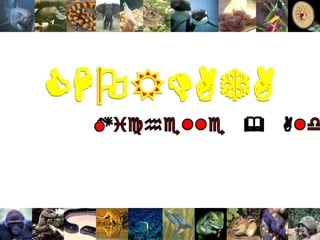
Chordata Animals with Notochords, Gill Slits & Tails
- 1. CHORDATA Michelle & Aldo
- 2. Chordata… Members of the Phylum Chordata include animals with which we are probably most likely familiar (including fish, birds, reptiles, amphibians and beasts like ourselves) As unlikely as it seems, based on embryological evidence, the echinoderms appear to be the most-likely ancestors to the early chordates Primitive stemmed echinoderms are thought to have shifted from arm-feeding to filter-feeding acquiring a body plan similar to urochordates Unfortunately, the fossil record is poor and intermediates are lacking. The rest of the evolutionary picture is better documented.
- 3. CHARACTERISTIC Four structural characteristics set chordates apart from all other phyla: a notochord a pharyngeal gill slits postanal tail a hollow dorsal nerve cord These attributes are always found in the larval forms or early embryo (although they may be absent in the adult).
- 4. The Notochord The notochord is mainly composed of fibrous connective tissue For those animals in which it persists into the adult form, the notochord provides support (it acts like our backbone) and increases swimming efficiency In animals like ourselves, bony structures called vertebrae develop near the notochord and eventually replace it during embryogenesis
- 5. Pharyngeal Gill Slits Pharyngeal gill slits are cuts in the pharynx that connect to a cavity surrounding the pharynx For organisms in which they remain in the adult, they are often elaborated into respiratory structures (and are sometimes involved in filtering food during feeding). The morphological equivalent of gill silts are seen briefly during our own development (weeks 4-5), but they usually close or develop into other structures Occasionally, the slits do not close, resulting in the newborn having an opening in the neck area (a cervical fistula).
- 6. In all the phyla we have studied up to this point, the anus was terminal (at the tip of the tail) Chordates, on the other hand, follow the anus with a tail of variable length (again, an adaptation for locomotion). In us, the tail is short and fused (the coccyx at the base of your spine). The Postanal Tail
- 9. EXAMPLES • sea squirts, lancelets, lamprey eels • sharks, rays, trout, bass, tuna • lungfish, frogs, salamanders • snakes, lizards • turtles, crocodiles, dinosaurs, birds • mice, elephants, whales, dogs, people
- 10. Phylum Chordata is divided into three subphyla: Subphylum Urochordata Subphylum Cephalochordata Subphylum Vertebrata
- 14. Subphylum Vertebrata Subphylum Vertebrata has several divisions you need to be familiar with: SuperclassTetrapoda Class Amphibia Order Caudata – Tailed Amphibians; Salamanders; Newts Order Anura – Tailless Amphibians; Frogs; Toads Order Gymnophiona – Caecillians Class Reptilia Subclass Anapsida – Turtles; Tortoises Subclass Diapsida – Crocodiles; Snakes; Lizards Class Aves Subclass Archaeornithes – Archaeopteryx (Extinct) Subclass Neornithes – All Other Birds Class Mammailia Subclass Prototheria – Monotremes – Platypus; Echinda Subclass Metatheria – Marsupials – Kangaroo; Koala Subclass Eutheria – Placentals
- 15. SuperclassTetrapoda SuperclassTetrapoda has four major class divisions: Class Amphibia Class Reptilia Class Aves Class Mammailia
- 16. ClassReptilia Reptiles have acquired several advances over amphibians that have allowed them to move successfully into terrestrial habitats. Their skin, for example, is more heavily thickened and is protected with surface scales that are impervious to water. A reptile's scales are very different in structure from that of fish. The outer layer of skin is a thick layer of dead, keratin-filled cornified cells. These cells are organized into horny scales covering the entire outer surface. Since reptiles have internal fertilization, water isn't even needed for mating.
- 17. There are two major subclasses: Subclass Anapsida – Turtles; Tortoises; some dinosaurs Subclass Diapsida – Crocodiles; Snakes; Lizards; most dinosaurs This is based on the presence or absence of certain temporal openings:
- 18. Class Aves The long hollow and porous bones of birds are thin and slender to aid in flight. Many bones overtime have fused together to give support. Teeth have been lost and replaced by a light beak. Feathers are cornified epidermal appendages that are probably related to scales. They are used for thermoregulation, communication, and as a flight surface. There are two subclasses of Aves: Subclass Archaeornithes (Extinct Archaeopteryx) Subclass Neornithes(All other birds)
- 19. Class Mammalia There are three subclasses based on birthing systems: Subclass Prototheria (egg-laying monotremes) Subclass Metatheria (marsupials) Subclass Eutheria (placental)
- 20. THANK YOU!!!